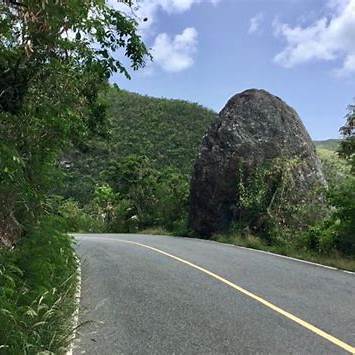Easter Rock of St. John, USVI: A Geological Marvel and Legendary Folklore
Easter Rock is a prominent geological feature located along North Shore Road on the island of St. John in the U.S. Virgin Islands. This massive, rounded boulder has long been a subject of local folklore and geological interest, symbolizing both the island’s rich cultural heritage and its dynamic geological past. As we get closer to Easter 2025, I wanted to bring attention to this popular local attraction.
Geological Origins
Approximately 100 million years ago, the Earth’s tectonic activity played a pivotal role in shaping the Caribbean region. The North American tectonic plate, moving westward, converged with the slower-moving Caribbean plate. This interaction caused the denser North American plate to subduct beneath the Caribbean plate, generating intense friction and heat. This heat melted subterranean rock, forming magma chambers. When pressure within these chambers became overwhelming, volcanic eruptions ensued, depositing vast sheets of magma onto the ocean floor.
Over millions of years, continued volcanic activity and tectonic uplift brought these submerged formations above sea level, giving rise to islands like St. John. During subsequent volcanic episodes in the area now known as Pillsbury Sound, explosive eruptions occurred in relatively shallow waters. These eruptions propelled massive rock fragments into the air, one of which landed near present-day Hawksnest Bay. This particular boulder is believed to be Easter Rock, standing as a testament to the island’s fiery origins.

Easter Rock, St. John
Cultural Significance and Legends
Beyond its geological importance, Easter Rock holds a cherished place in local folklore. According to legend, on the night before Easter Sunday, the boulder embarks on a mystical journey. It is said to roll down from its perch to the waters of Hawksnest Bay to take a drink, returning to its original position before dawn. This nocturnal excursion is believed to leave the rock wet on Easter morning, even during periods of drought. While no one has witnessed this event firsthand, the legend persists, adding an element of mystery and enchantment to the rock.
This tale has been passed down through generations, becoming an integral part of St. John’s oral history. Children and adults alike share stories of attempting to observe the rock’s midnight journey, only to find it steadfastly in place by morning. Such legends contribute to the island’s rich tapestry of cultural narratives, reflecting the community’s deep connection to their natural surroundings.
Easter Traditions and Community Engagement
The legend of Easter Rock has also influenced local traditions. Residents often recount tales of their youth, when they would sneak out on Easter Eve, hoping to witness the rock’s descent to the sea. These stories, whether believed or taken with a grain of salt, foster a sense of community and shared heritage among St. Johnians.
In recent years, local organizations and social media platforms have highlighted the legend, encouraging both residents and visitors to engage with this unique aspect of St. John’s culture. For instance, the Friends of Virgin Islands National Park have shared stories and historical accounts related to Easter Rock, sparking interest and discussions about its place in the island’s heritage.
Easter Rock in Literature and Media
The mystique of Easter Rock has also found its way into literature and media. Local authors have penned stories and articles that delve into the rock’s legend, exploring themes of tradition, belief, and the interplay between natural history and folklore. These narratives serve to preserve and disseminate the cultural significance of Easter Rock, ensuring that its story remains a vibrant part of St. John’s identity.
Geological Studies and Tourism
While the legend captivates the imagination, Easter Rock also attracts the attention of geologists and tourists. Geologists are intrigued by its composition and origin, seeing it as a tangible link to the island’s volcanic past. Tourists, on the other hand, are drawn to the rock not only for its impressive stature but also for the rich stories that surround it. Many visitors include a stop at Easter Rock in their explorations, eager to photograph the boulder and learn about its dual significance in geology and local lore.
Preservation and Education
Recognizing the importance of Easter Rock, local organizations have undertaken efforts to preserve its physical state and promote its story. Educational programs aimed at both residents and visitors emphasize the rock’s geological formation and its cultural narratives. By doing so, they aim to foster a deeper appreciation for the island’s natural landmarks and the stories that have grown around them.

Easter Rock as seen driving East on the North shore road
In conclusion, Easter Rock stands as a multifaceted symbol on St. John, embodying the island’s geological history and its rich tradition of storytelling. Whether viewed through the lens of science or legend, the boulder continues to captivate the minds and hearts of those who encounter it, ensuring its place in the annals of St. John’s enduring heritage.
